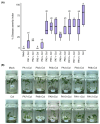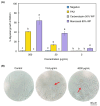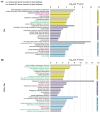Rhamnolipid-Enriched PA3 Fraction from Pseudomonas aeruginosa SWUC02 Primes Chili Plant Defense Against Anthracnose
- PMID: 39684305
- PMCID: PMC11641530
- DOI: 10.3390/ijms252312593
Rhamnolipid-Enriched PA3 Fraction from Pseudomonas aeruginosa SWUC02 Primes Chili Plant Defense Against Anthracnose
Abstract
Chili anthracnose, caused by Colletotrichum truncatum, causes significant yield loss in chili production. In this study, we investigated the elicitor properties of a rhamnolipid (RL)-enriched PA3 fraction derived from Pseudomonas aeruginosa SWUC02 in inducing systemic resistance in yellow chili seedlings and antifungal activity against C. truncatum CFPL01 (Col). Fractionation of the ethyl acetate extract yielded 12 fractions, with PA3 demonstrating the most effective disease suppression, reducing the disease severity index to 4 ± 7.35% at 7 days post-inoculation compared with Col inoculation alone (83 ± 23.57%). PA3 also exhibited direct antifungal activity, inhibiting Col mycelial growth by 41 ± 0.96% at 200 µg/mL. Subfractionation revealed PA3 as a mixture of mono- and di-RLs, confirmed by 1H nuclear magnetic resonance and electrospray ionization mass spectrometry data. Additionally, PA3 enhanced seed germination and promoted plant growth without causing phytotoxicity. Transcriptomics revealed that PA3 pre-treatment prior to Col infection primed the defense response, upregulating defense-related genes involved in the phenylpropanoid, flavonoid, and jasmonic acid biosynthesis pathways, as well as those associated with cell wall reinforcement. Our findings highlight the potential of RL-enriched PA3 as both an antifungal agent and a plant defense elicitor, with transcriptome data providing new insights into defense priming and resistance pathways in chili, offering an eco-friendly solution for sustainable anthracnose management.
Keywords: Colletotrichum; Pseudomonas; anthracnose; biocontrol; chili plant; elicitor; induced systemic resistance; rhamnolipid; sustainable agriculture; transcriptome.
Conflict of interest statement
The authors declare no conflicts of interest.
Figures










Similar articles
-
Unlocking the Potential of Pseudomonas aeruginosa SWUC02: Cell-Free Supernatant and Extracts for Controlling Anthracnose Disease and Inducing Resistance in Yellow Chilli Seedling.Trop Life Sci Res. 2025 Mar;36(1):25-42. doi: 10.21315/tlsr2025.36.1.2. Epub 2025 Mar 30. Trop Life Sci Res. 2025. PMID: 40276049 Free PMC article.
-
Antifungal properties of rhamnolipid produced by Pseudomonas aeruginosa DS9 against Colletotrichum falcatum.J Basic Microbiol. 2015 Nov;55(11):1265-74. doi: 10.1002/jobm.201500220. Epub 2015 Jul 15. J Basic Microbiol. 2015. PMID: 26173581
-
Bacillus velezensis and Zinc Oxide Nanoparticles in Suppressing Colletotrichum capsici-Induced Anthracnose Disease in Chili: Mechanistic Insights Into Antioxidant System and Plant Growth.Physiol Plant. 2025 May-Jun;177(3):e70330. doi: 10.1111/ppl.70330. Physiol Plant. 2025. PMID: 40525478
-
Breeding for Anthracnose Disease Resistance in Chili: Progress and Prospects.Int J Mol Sci. 2018 Oct 11;19(10):3122. doi: 10.3390/ijms19103122. Int J Mol Sci. 2018. PMID: 30314374 Free PMC article. Review.
-
Non-Chemical Treatments for the Pre- and Post-Harvest Elicitation of Defense Mechanisms in the Fungi-Avocado Pathosystem.Molecules. 2021 Nov 11;26(22):6819. doi: 10.3390/molecules26226819. Molecules. 2021. PMID: 34833910 Free PMC article. Review.
References
-
- Karim K.M.R., Rafii M.Y., Misran A.B., Ismail M.F.B., Harun A.R., Khan M.M.H., Chowdhury M.F.N. Current and prospective strategies in the varietal improvement of chilli (Capsicum annuum L.) specially heterosis breeding. Agronomy. 2021;11:2217. doi: 10.3390/agronomy11112217. - DOI
-
- del Carmen Orozco-Mosqueda M., Fadiji A.E., Babalola O.O., Santoyo G. Bacterial elicitors of the plant immune system: An overview and the way forward. Plant Stress. 2023;7:100138. doi: 10.1016/j.stress.2023.100138. - DOI
MeSH terms
Substances
Grants and funding
LinkOut - more resources
Full Text Sources

